| March 2009 Index | Home Page |
Editor’s Note: This study is of particular interest to those who teach using this technology. Certainly, the positive results are justified. However, more research is called for to establish the reality of this education format and eliminate any question of a “Hawthorne” effect.
Using Asynchronous Video in Online Classes:
Results From a Pilot Study
Michael E. Griffiths and Charles R. Graham
USA
Abstract
The purpose of this study was to show how asynchronous video communications between instructors and students can capture verbal and non-verbal cues to establish a high level of Social Presence and Instructor Immediacy in an online setting. Fifty pre-service teachers at Brigham Young University took part in a new online section of the class entitled “Effective integration of technology in teaching” in which the instructional materials were mostly in the form of video clips recorded by the instructor, and in which students responded to assignments by recording their answers and responses in webcam video clips that were sent to the instructor. The instructor gave feedback to individual students in the form of recorded webcam video clips. Data for this study include instructor and student perceptions. Student data is in the form of student ratings scores and comments that are given anonymously as part of normal end of class procedures for all classes at BYU.
Keywords: Action research; asynchronous discussion; asynchronous video; webcam; online discussion; immediacy; social presence; teaching presence.
Introduction
The Effective Integration of Technology in Teaching (IP&T 287) is a class that is required for all elementary education students in teaching undergraduate programs at Brigham Young University (BYU). The purpose of the class is to teach students how to effectively implement technology into teaching and to give them exposure to several relevant educational technology tools that relate to early childhood and elementary-aged children. As this class has developed over the last several years, one particular challenge has consistently arisen; there is usually a wide range of technology skills amongst the students in the class and therefore it is difficult to know how to pace the instruction and project work. For some students the pace is too slow and they feel that their time is wasted, for others the pace is too fast and they feel like they have not had enough time to grasp the technologies. For Winter 2008 it was decided to teach the class in an online format to allow students more flexibility with the pace of the class.
The online section incorporated the use of asynchronous video messages (recorded with webcams) between students and the instructor for many of the class assignments. Students were offered the choice of taking the class either online or face-to-face. For the online class, instructional materials were recorded. Video clips of the instructor discussing and presenting topics and instructions for completing projects and assignments were either in the same video-clip format or in text format. Other materials included video clips narrated by the instructor demonstrating the various educational software tools that they were required to use. In addition, the instructor recorded additional video clips on a weekly basis that were sent to all students with messages of encouragement, reminders, and announcements. The class and, in particular, the asynchronous video format is the subject of this action research study. This paper describes the feedback from students collected as part of the standard student ratings system and also the observations and perceptions of the instructor.
Instructor Immediacy and Social Presence
Online courses have many benefits over face-to-face instruction that include increased access, improved quality of learning, better preparation of students for a knowledge-based society, and "lifelong" learning opportunity (Appana, 2008). Notwithstanding the ever increasing popularity of online courses, it is recognized that there are also limitations in their ability to replicate critical features of a normal classroom environment such as social interaction, prompt feedback, engaging activities, instructional flexibility, the dynamism of a knowledgeable scholar, and adaptation to individual needs (Larreamendy-Joems & Leinhart, 2006). It has been shown that certain elements of social interaction can be replicated in some degree through text based asynchronous learning environments (Rourke, Anderson, Garrison & Archer, 1999). However, the medium of text does not have the capacity to include the richness of all the senses implicit in face-to-face human interaction (Graham, 2006). Social interaction is one of the most obvious limitations of online learning. In an educational context, social interaction has multiple facets that include the individual student-instructor relationship and the overall learning community which includes the instructor and all students.
Close social interaction between teacher and student which is one important facet of the overall domain of social interaction is often discussed in terms of Instructor Immediacy. Immediacy is defined as those communications behaviors, some visual others vocal, that enhance closeness to and non-verbal interaction with another (Mehrabian, 1969). Rovai (2000) elaborates that Instructor Immediacy is the immediate verbal and non-verbal communications such: as smiles, head nods, use of inclusive language, and eye contact, which promote increased learning. Both Christophel (1990) and Christensen (1998) add the distinction that improved teacher immediacy impacts student motivation which in turn improves student learning. These studies suggest that immediacy has an indirect rather than a direct impact on student learning since it is, in reality, student motivation that directly impacts student learning. As the natural level of motivation is different in all students, it is reasonable to assume that Instructor Immediacy would most likely have the lowest level of impact on students with high natural levels of motivation. Frymier (1993) investigated the interaction of students’ motivation to study and instructors’ immediacy in a traditional face-to-face learning environment. Her research concluded that students who began a course with low to moderate motivation to study had increased motivation to study after interacting with a highly immediate instructor, while students with a high level of motivation were unaffected by the high level of immediacy. With the evidence suggesting that close social interaction, or immediacy, between an instructor and a student is correlated with student motivation especially for students who have a low to moderate natural level of motivation, there is an obvious need to investigate the Instructor Immediacy limitations that exist in online learning. Rovai (2002) states that the verbal and non-verbal communications included in Instructor Immediacy can be easily transmitted in the close physical proximity of the instructor and student in a face-to-face classroom setting.
Online learning environments do not have the advantages of the close proximity and all of the sensory perspectives and perceptions that are available in the face-to-face setting. Due to this dynamic it may be reasonable to assume that Instructor Immediacy is a less likely product of an online class. The Community of Inquiry Framework (Garrison & Archer, 2003) situates the principle of Instructor Immediacy mostly within the domain of Social Presence. In the Community of Inquiry Framework, Social Presence is described as, “The ability of participants to identify with the community (e.g., course of study), communicate purposefully in a trusting environment, and develop inter-personal relationships by way of projecting their individual personalities” (Arbaugh, Cleveland-Innes, Diaz, Garrison, Ice, Richardson, et al., 2007). Using Social Presence as an approach, the issue of verbal and non-verbal cues involved in projecting immediacy is discussed in terms of projecting individual personalities. Therefore in the context of this theoretical approach, the establishing of Social Presence in an online setting is not easy due to the lack of verbal and non-verbal cues and the sensory perspectives and perceptions that exist in a close proximal setting.
The Challenges of Using Live Video
Some access to verbal and non-verbal communication can be available in an online setting through audiovisual technologies. Audiovisual technologies such as teleconferencing and webcams can be used synchronously and asynchronously. With the capacity to deliver verbal and non-verbal communication, audiovisual technology is a medium that can be used to facilitate the communication of Instructor Immediacy and establish Social Presence. Live video has become a popular medium in many online settings including education. However, there are substantial limitations that currently exist in using live video as a medium in online learning environments.
Live video conferences require a high level of coordination, and are subject to many technical problems that can cause the experience to be negative for students. There is an expectation of video conferences that they will replicate the essence of a close physical location experience, and while expensive videoconferencing equipment that is often used in commercial settings works well, the most available inexpensive technologies involving video through the internet are subject to bandwidth restrictions, and software/hardware issues. When these problems occur, a video conference can often be a disappointing experience. Also, video conferences take away one of the main benefits of online learning; learner time flexibility. Online students have the benefit of choosing the time and circumstances of their learning experience, and that benefit is removed when they are required to participate in live video conferences.
Asynchronous Video
The other type of audiovisual communication available to online learning environments is asynchronous video communication. Asynchronous video communications that are in the form of clips recorded by the students or by the instructor that are then sent to another party may provide a potential way of solving some of the Social Presence problems of online environments. In fact, even asynchronous audio communication alone has demonstrated the ability to convey some degree of Social Presence. Following their study on the use of asynchronous audio as a tool from instructors to communicate feedback to students, Ice, Curtis, Phillips and Wells (2007) state that audio feedback was associated with feelings of increased involvement and enhanced learning community interactions. Video clips add visual elements to the audio and thus add the possibility of communicating visual as well as verbal cues to asynchronous communications.
Self recorded video clips contain many of the verbal and non-verbal cues that exist in a face-to-face environment. These asynchronous forms of video communications, although not as rich as a live experience in totality, are not bound by the same network and software problems as live video conferences, and the expectations of the experience are completely different. An asynchronous video communication can always be re-recorded before being sent or replayed many times whereas if a problem occurs in a live video conference, the time and content relating to the length of the problem are most likely lost. The affordance of asynchronous video communication is an area for exploration as to how it could help to establish a high level of Social Presence and immediacy in online educational settings.
Purpose of this Study
The overall purpose of this study was to observe the impact of personalized asynchronous video communication between instructor and students on the motivational level of the students. As motivational levels of students has been shown to be affected by Social Presence and immediacy, the specific question addressed in the study is whether personalized asynchronous video communications from instructors to students can capture a sufficient level of verbal and non-verbal cues to establish a high level of Social Presence and immediacy.
Research Methodology
The use of asynchronous video for instructor presentation, student assignment, and instructor feedback is an innovative intervention that was used for the first time at BYU in the online section of IP&T287 in the Winter semester of 2008. The method for studying the results of this intervention is predominately based on two of the Sloan Pillars, which are Student Satisfaction and Teacher Satisfaction. The analysis of Student Satisfaction is based upon data from the BYU Student Ratings system which for the purpose of this study consists of 16 Likert scale questions, and one open ended question. Of the 16 Likert scale questions seven are focused on student perceptions of the course, eight are focused on student perceptions of the instructor, and one is focused on student perceptions of the overall quality of the course and the instructor. The open ended comments are studied using a thematic analysis where elements of comments are categorized by a positive or negative statement regarding the effectiveness of the course, the attitude of the instructor, the online nature of the course, and the asynchronous video communications. The analysis of Teacher Satisfaction is based upon field note entries made by the instructor throughout the semester as well as instructor reflections and observations that were made after the end of the class.
Pilot Study: Asynchronous Video in an Online Course
Structure of the Course
The only time that the whole class met together was the first day of class where the instructor briefly explained the online class structure. The students were then required to go to the class website using the internet and to follow the instructions on the site. The first thing that students were required to do was to watch a video clip in which the instructor introduced themselves and then explained the goals and objectives of the class.
One assignment in the first section of the class required students to record a webcam clip to send to the instructor. In this clip, students were required to introduce themselves, describe something unique about themselves, and to respond to a discussion question. Video clips were sent to the instructor as email attachments. On the class website, there were instructions in the form of video clips showing how to use Windows Movie Maker to record video clips in the correct format. On reception of each video clip sent by students, the instructor recorded a video clip of themselves in which the instructor responded to the personal introduction given by the student, expressed encouragement, and stressed that the instructor would do their best to help when needed, and finally gave some feedback on the student’s response to the discussion question.
Students sometimes watched video clips of the instructor presenting topics reinforced with diagrams and pictures. Most of the assignments involved using software programs such as Photostory, Google Earth, Movie Maker and suchlike to produce projects that could be used in a K-12 setting. The class website included textual instructions on the requirements of assignments and, in most cases, screen capture video clips showing how to use the software applications. Several assignments required the students to record a video clip of themselves explaining the rationale for their projects or responding to a discussion question. From time to time the instructor sent emails with encouragement and reminders, and several times the instructor sent these messages in the form of recorded video clips instead of textual messages. The final class assignment required each student to send a video clip to the instructor answering several final exam questions and also giving general feedback on the class.
Student Ratings Data
All students at BYU are invited and encouraged to submit ratings for each class that they attend. The ratings are anonymous and instructors can only view the ratings after student grades are submitted. This paper examines 10 Likert scale questions from the BYU student ratings system. Each question has eight possible responses that generate a score of one to eight. In all cases the lowest response equates to a score of one and the highest score equates to a score of eight. Therefore if a course receives an overall score of eight for one of the questions that means every student that rated the course gave it the highest score for that item. For each of the 10 Likert scale questions discussed in this study, the score for the online section of IP&T287 that is the object of this study, with all other sections of IP&T287 in Winter 2008 (N=4), and all courses in the School of Education at BYU in Winter 2008 (N=385), and finally with all courses at BYU in Winter 2008 (7065). For the online section of IP&T287, 38 of 50 (76%) of students completed the student ratings.
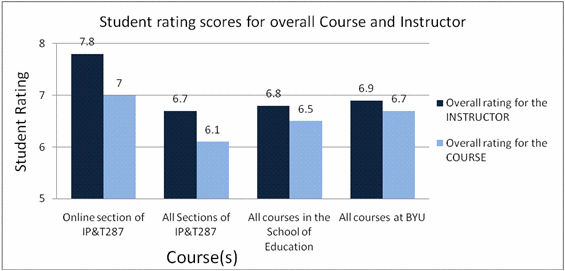
Figure 1: Student rating scores for overall Course and Instructor
Figures one to five compare the student ratings of the online course with average from all four sections of IP&T287 taught in Winter 2008, and with the overall ratings for all course in the school of Education, and with the overall ratings for all courses at BYU. All sections of IP&T287 had a similar number of students, and three of the sections were traditional face-to-face classes with the online section being the fourth. Figure 1 shows the results of the two ratings items that measure overall student perceptions of the instructor and the course. For these two rating items, students can select from the following scale: Very Poor, Poor, Somewhat Poor, Fair, Good, Very Good, Excellent, and Exceptional. Very Poor is a score of one and Exceptional is a score of eight.
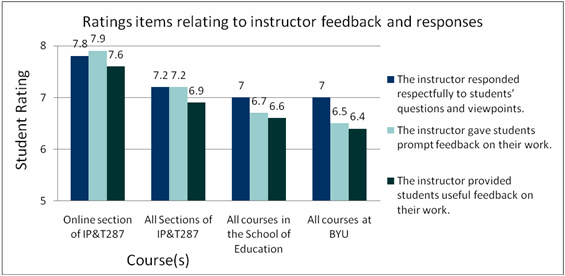
Figure 2: Ratings items relating to instructor feedback and responses.
Figure 2 shows the results for three student ratings questions that relate to instructor feedback and instructor responses. Figures 2 – 5 shows the student ratings results for the other eight student ratings questions that are included in this analysis. For each of these eight questions, students can select from the following scale: Very Strongly Disagree, Strongly Disagree, Disagree, Somewhat Disagree, Somewhat Agree, Agree, Strongly Agree, and Very Strongly Agree. Very Strongly Disagree is a score of one, and Very Strongly Agree is a score of eight.
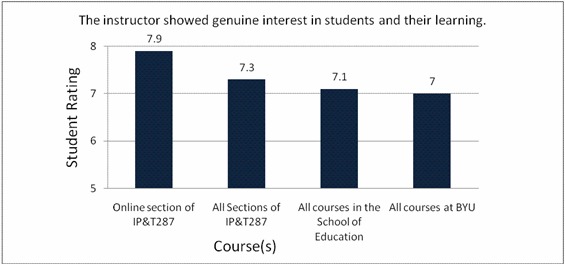
Figure 3: Ratings: The instructor showed genuine interest in students and their learning.
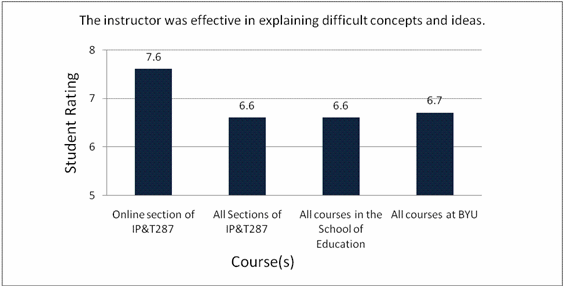
Figure 4: Ratings: The instructor was effective in explaining difficult concepts and ideas.
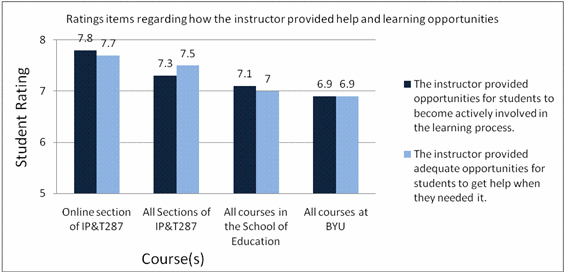
Figure 5: Ratings: how well the instructor provided help and learning opportunities.
Figure 3 shows the results of a ratings item that shows students perception of how genuinely interested they felt the instructor was in their learning and in them personally. Figure 4 shows the results of a rating item that shows students perceptions of how effective the instructor was in explaining concepts. Figure 5 shows the results of two rating items that show student perceptions of how well the instructor provided help and active involvement in the learning process.
Student Ratings Comments
At the end of the student ratings online form for each course, students are invited to add open-ended comments with the following instructions: “Please add any comments or suggestions you have about your learning experience in this course with this instructor.” For the online section of IP&Y287, 28 of the 38 students that completed the student ratings chose to leave comments. A thematic analysis of these comments resulted in finding 133 distinct statements that were made. The 133 distinct statements were categorized by the 14 themes shown in Table 1, and each distinct statement was also defined as being either a positive statement, a negative statement, or a statement that simply described some kind of difficulty experienced in the class. Statements that are negative or reporting a difficulty are shown in italics. Table 1 shows that 127 out of 133 statements were positive about some aspect of the instructor or of the course and only two statements were considered to be negative.
Instructor Perceptions
The field notes that were recorded by the instructor at regular intervals in the Winter 2008 semester provide the basis for an analysis of instructor perceptions of the course. The instructor reported that although there was a fair amount of extra work involved in the initial design and set up of the online class, the actual running of the class was no more difficult or burdensome than the face-to-face version. In terms of overall time commitment, the instructor stated that the online version of the class actually took less of his time, and that it changed the way he worked. He would read emails, watch video clips, and respond to individual students at various times of the day including evenings and weekends whenever he happened to be online. This is in comparison to the face-to-face class where he would store up assignments to grade at regular intervals. The instructor declared that this actually reduced stress as a large pile of work rarely accumulated. However, the instructor recognized that this pattern of flexibility suited him personally, but might not suit other instructors.
The instructor stated that the video clip presentations by students were a better representation of their actual level of knowledge than the written assignments that are required in the face-to-face class. The instructor also reported that the responses contained more information, and that he was able to more accurately discern the knowledge and skills of the students due to the audio-visual cues inherent in a video clip presentation. The instructor also stated that they knew more about each individual student than he felt was possible in the face-to-face class setting, which meant that he was consequently more able to respond to the individual needs of each student. The instructor stated that he did not think that there were many benefits of the face-to-face class that were lacking in the online class with the exception of the dynamic nature of class brainstorming that he stated was a helpful part of the learning process for the face-to-face students.
Table 1
Thematic Analysis of Student Comments from the Student Ratings System
Theme of statement | Positive | Negative | Difficulty | Example |
Perception of instructor in general | 18 | The instructor was personable with the students even though this was an online section. | ||
Perception of instructor care/concern | 18 | The instructor really showed that he cared about us as students. | ||
Perception of course in general | 17 | Overall, this class was a really good experience. | ||
Perception of the online method | 17 | I loved doing this class online and being able to work at my own pace. | ||
Perception of help/responsiveness of instructor | 15 | The instructor with this course was extremely helpful. | ||
Perception of activities/materials | 8 | 1 | I felt like the assignments we did were directly applicable to my teaching. Some of them took a very long time to complete. | |
Perception of instructor as inspiring or motivational | 9 | The instructor encouraged us in our assignments. | ||
Perception of learning experience | 8 | I learned a lot of valuable information in this course. | ||
Perception of the organization of the course | 6 | 1 | Course was very well organized. Obviously this was the first time this class has been online, so hopefully next semester it will be a little more organized. | |
Perception of communication in the course | 5 | Instructor was very good at communication between teacher and students - especially for an online class. | ||
Perception of the use of webcam video clips | 5 | It was much more personal this way, even more so than a face-to-face class usually is. | ||
Perception of technical Issues | 3 | The main reason this class is hard to take online is because if the many technical difficulties I and others experienced. | ||
Perception of feedback/grades | 1 | The only problem is we received feedback not necessarily any grades. | ||
Perception of one-on-one time with instructor | 1 | Even though this was an online course and I did not see the instructor as much as my other professors, he provided me more help and one on one time than any other professor. |
Results and Discussion
The overall perception of the instructor of the online class is that the asynchronous video communications method did seem to allow for the establishing of Social Presence and Instructor Immediacy, and in addition, the asynchronous video communications method resulted in some other surprising benefits that at a first glance appear to positively impact the overall quality of student learning. The student ratings scores for the online section of the class show if nothing else that the student perception of the class is very positive in comparison with other classes. For every single student ratings item, the online section of IP&T287 is rated higher than the average score of all sections of IP&T287, higher than the average score of all courses in the School of Education, and higher than the average of all courses at BYU. There may be many reasons why this would be the case that are not connected to the use of asynchronous video, and the only sure statement that can be made regarding the student ratings scores is that the students had a very favorable perception of the online class when compared with other courses.
The voluntary comments made by students as part of the student ratings process reveal more detail about student perceptions. The distinct statements that were analyzed in this study reveal clearly articulated and highly positive student perceptions. Student statements suggest that Instructor Immediacy and the Social Presence of the instructor were achieved and that students even felt that certain aspects of the class were superior to their experience of face-to-face classes. One student stated that the experience was more personal than a face-to-face class, and another student stated that felt that they had more one-one-one time with the instructor than in face-to-face classes.
In addition, the instructor states that the student responses in the format of recorded video clips gave the instructor a much better level of understanding of the depth of knowledge of the students than can normally be ascertained through written responses. It would perhaps be possible to obtain this same result in a face-to-face class by having an oral interview with each student for each assignment, but the time and organization that would be required to achieve this is simply impractical. It may also be the case the students can respond more freely and naturally to assignments on a webcam than they could if they were in the physical presence of the instructor. With that being the case, it appears that using asynchronous video combines the benefits of face-to-face personalized communication and evaluation with the efficiency and flexibility of asynchronous online education.
Another benefit that has emerged as a result of using the asynchronous video communications is that the instructor-student relationship seems to have been stronger. In effect, students reported feeling more individual contact and a more personal relationship, and the instructor reported that they felt that they knew more about individual students, their individual situations and learning needs than would normally be possible. As an example, the first webcam message that students were required to send required an introduction including something unique about themselves. The instructor was able to observe this introduction, listening to the words while observing the face and body language of the student giving a vivid personal introduction. Also, students were able to express some unique and interesting things about themselves that helped the instructor know them better as individuals. Although this can be achieved in a face-to-face class, it is rare for every student in a class of 50 to give a 3 minute introduction of themselves as it takes so much class time.
The instructor was able to personalize a video reply to each of the student introductions which began the process of an individual dialog between the instructor and each student. This pattern created in some degree an individualized class experience for each student. No student was able to hide in a corner in class as timid students can sometimes do, and no student was able to dominate the discussion as some students can sometimes do. These are some of the regular benefits of online education, but the asynchronous video brought in an aspect of face-to-face education that is normally lacking in an online setting. Every student communicated in video format several times with the instructor, and every student received an equal amount of attention in video format from the instructor. The perception of the instructor is that seeing a student present themselves in a video, and having students see the instructor give feedback and encouragement in a video, creates a real and personal connection that rivals, and in some ways exceeds the level of personal connection that can be achieved in a face-to-face class.
The students’ comments also revealed that they enjoyed the online nature of the class and how it gave them flexibility and the ability to work at their own pace. This factor alone may well positively impact all other factors in the minds of students. However it is difficult to ignore the overwhelmingly positive student ratings scores and student comments relating to all aspects of the class. Placing this study in context, the instructor also taught a face-to-face section of IP&T287 in Fall 2007. That class followed a very similar syllabus to the online class and was in the format of one two hour class session per week. The instructor and the course received higher than average student ratings scores, but not as high as was received for the online section, and additionally, many students’ comments contained negative statements. Out of 105 distinct statements made by students in the face-to-face section, 23 (22%) were negative. In the online section that is the subject of this study, only two of 133 statements were considered to be negative. Although the exact reasons are difficult to confirm conclusively, it is clear that the online section was positively perceived by students, and it was clearly more universally appreciated by students than the most comparable face-to-face version of the class.
Conclusions
The online section of IP&T287 was a pilot study of both the suitability of teaching IP&T287 in an online setting and of the potential of asynchronous video as a class communications method. For this initial pilot study and the time constraints involved it was not possible to design and implement a more robust study methodology. However, the online class and especially the asynchronous video communications were so well received by students, and many aspects of the class success were surprising and exciting to the degree that a need was felt to publish the results of the pilot study. In addition, the results of this pilot have caused several other instructors in the School of Education to use the asynchronous video method to varying degrees. A larger scale study involving all of these sections will be carried out and will incorporate the measurement instrument for the Community of Inquiry Framework. It is also recommended that the asynchronous video communications method be tested and studied in variety of other institutions in order to provide different perspectives.
Asynchronous video communication may well be a technological method that can bridge the gap between the worlds of online and face-to-face education, and gain the best from both worlds. Face-to-face education has the highest level of affordance for Social Presence and Instructor Immediacy, and online education has the highest level of affordance for flexibility in time and geographical distance and for personalized instruction. Asynchronous video appears to have a high affordance for Social Presence and Instructor Immediacy and, in addition, has the capacity to bring the richness of face-to-face communication to the personalized instruction of online education. Finally, unlike live streaming video, asynchronous video retains the time flexibility benefits of online education. Is it possible that such a simple approach as asynchronous video using webcams could actually be a way to gain the best of both educational worlds? Perhaps so, and it is recommended that development continue in the use of asynchronous video via webcam as an educational communications method.
References
Appana, S. (2008). A Review of Benefits and Limitations of Online Learning in the Context of the Student, the Instructor, and the Tenured Faculty. International Journal on E-Learning, 7(1) 5-22.
Arbaugh, J. B., Cleveland-Innes, M., Diaz, S., Garrison, D. R., Ice, P., Richardson, J., et al. (2007). Community of Inquiry Framework: Validation & Instrument Development. 13th Annual Sloan-C Conference. Orlando, FL.
Garrison, D. R. (2003). A theory of critical inquiry. In M. G. Moore & W. G. Anderson (Eds.), Handbook of distance education (pp. 115). Mahwah, NJ: Lawrence Erlbaum Associates.
Graham, C. R. (2006). Blended learning systems: Definition, current trends, and future directions. In C. J. Bonk & C. R. Graham (Eds.), Handbook of blended learning: Global perspectives, local designs (pp. 3-21). San Francisco, CA: Pfeiffer Publishing.
Christophel, D. (1990). The Relationships among Teacher Immediacy Behaviors, Student Motivation, and Learning. Communication Education, 39 (4), 323-40.
Christensen, L., & Menzel, K. (1998). The Linear Relationship between Student Reports of Teacher Immediacy Behaviors and Perceptions of State Motivation, and of Cognitive, Affective, and Behavioral Learning. Communication Education, 47(1), 82-90.
Frymier, A. (1993). The impact of teacher immediacy on students’ motivation over the course of a semester. Paper presented at the Annual Meeting of the Speech Communication Association, Miami Beach, FL
Ice, P., & Curtis, R., & Phillips, P., & Wells, J. (2007). Using Synchronous Audio Feedback to Enhance Teaching Presence and Students’ Sense of Community. Journal of Asynchronous Learning Networks, 11(2).
Larreamendy-Joems, J., & Leinhart, G. (2006). Going the Distance With Online Education. Review of Educational Research, 76(4), 567-605.
Mehrabian, A. (1969). Some Referents and Measures of Non-verbal Behavior. Behavioral Research Methods and Instruments, 1, 213-217.
Rourke, L. & Anderson, T. & Garrison, R. & Archer, W. (1999). Assessing Social Presence In Asynchronous Text-based Computer Conferencing. The Journal of Distance Education, 14(2).
Rovai, A. (2000). Building and sustaining community in asynchronous learning networks, The Internet and Higher Education, 3(4), 285-297.
Rovai, A. (2002). Building Sense of Community at a Distance. Review of Research in Open and Distance Learning, 3(1).
About the Authors
Michael Griffiths is a Senior Project Manager in the Center for Teaching and Learning at Brigham Young University (BYU). Michael received an MS from the department of Instructional Psychology and Technology at BYU where he is also in the process of completing a PhD. Michael spent 16 years in the field of Information Technology including running a software business before changing paths to begin a career in the field of education. Michael has also been a Trustee and CFO of two new charter schools in Utah. Michael is particularly interested in studying and innovating online learning environments. EMAIL: mike_griffiths@byu.edu | |
Charles R. Graham is an Associate Professor of Instructional Psychology and Technology at Brigham Young University with a focus on technology-mediated teaching and learning. Charles is particularly interested in studying the design and evaluation of blended learning environments. EMAIL: Charles_graham@byu.edu |

